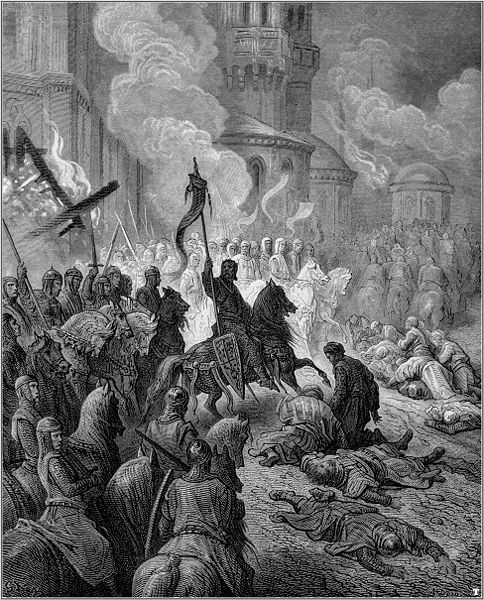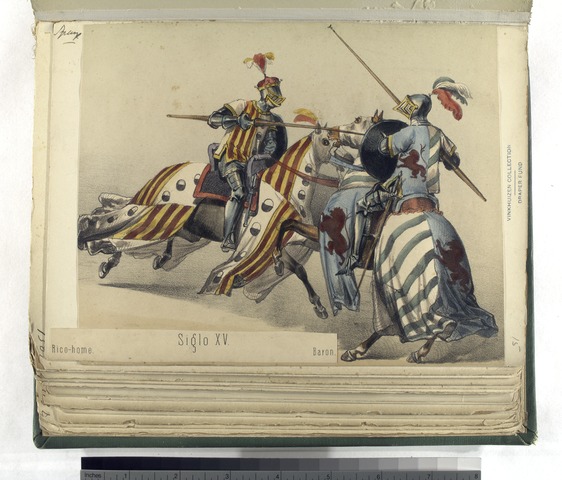The knights were the equestrian warrior class of medieval Europe, a land-holding noble defined by his ability to effectively ride a heavy horse into battle. While there were many horse-riding fighters the world over, what set these European fighters apart was the fact that they fought by using their horse itself as a weapon, preferring the heavy-set destriers as warhorses and crashing them into enemy ranks.

Helpfully demonstrated her by King Richard the Lionheart during his battle with Saladin at Arsuf in Gustave Dore’s famous illustration: Source
Not unlike the samurai half a world away, knights valued their own skills at arms so much that they often feuded with one another (hence, Feudalism) and picked petty arguments just so they could fight. Because most rulers are fairly invested in having peaceful kingdoms where their residents are not constantly being plundered by their neighbors, the kings and popes of medieval times promoted different means to try and make their fighters more peaceful, at least at home.
1. The Crusades
Why not send these knights on a little vacation, complete with burning and pillaging places that are both far from home and filled with people who look and worship differently? The Crusades were useful for sending troublesome ambitious fellows to fight with infidels over scraps of holy land. While originally meant as a gesture of reconciliation between the Roman Catholic and what we now refer to as the Eastern Orthodox Churches, these adventures were also useful for getting rid of problem knights and gaining favor with the Pope.
The Crusades ironically inspired new knightly orders and helped solidify a special relationship between knights and the church. Knights began to see themselves as the protectors of Christendom against the encroaching armies of Islam. However, whatever these cavalier fellows possessed in bravery and piety, they lacked in proper targeting. The first crusade mercilessly sacked Jerusalem, slaughtering Muslims and eastern Christians alike. The fourth crusade veered from its course to Jerusalem and instead became a Venice-sponsored sacking of Constantinople. Whatever their usefulness in removing belligerent landholding warriors, they fell into historical infamy as the crusading spirit turned inward, purging Europe of Jewish communities and the few remaining pagan groups still practicing their religion in the hinterlands.

“Oh, uh, sorry. Wrong turn.”
The Crusaders Enter Constantinople by Gustave Dore Source
2. Chivalry
A lot of people complain that chivalry is dead. Those people have no freaking idea how lucky we are that it finally died. Chivalry was an attempt to romanticize knighthood by giving it virtues and behavioral guidelines. At best, it encouraged knights to seek out fellow nobles when on the battlefield rather than slaughtering conscripted peasants. At worst, it was nothing more than a loosely-adhered set of rules that helped knights get laid at tournaments.

Siglo XV. Rico-home; Baron 1502 Source
Chivalry, as an idea, began with the popular anonymous poem “Ordene de Chevalerie” which described the rituals of European knighthood. This, combined with a few later works, built a framework of proper conduct for the knightly class, most notably bravery in battle, politeness and deference toward fellow nobles, and protection of the church.
The church was happy to be mentioned but disapproved sharply of the pop-culture equivalent of the time which found its way into chivalry – the medieval ideal of love. Marriage, for example, was considered an obligation to nobles, not some love-based commitment. Love, the average knight believed, was best expressed when neither party had an obligation to the other at all; it was freely given and freely received. Remarriage was generally not the goal of an illicit couple because that would ruin the freedom of their love. Obviously the church did not approve of knights stepping out on their wives and those who were caught suffered vicious punishments.
For all its romanticism, chivalry was never universally held and has mostly been retconned into history by romantics. For some it was a cultural set of standards, for others merely a curiosity they pondered and then shrugged and returned to plunder and pillage. Worse, some understood that the chivalric values of fair fighting, mercy in victory, and respect for one’s foe were rules that only applied to fellow members of the nobility. Commoners were regularly made to suffer mistreatment by knights who were still considered chivalrous. Consider this example:
The deviser of the affair, “cruelest and most insolent of men,” was one Huguet de Guisay, favored in the royal circle for his outrageous schemes. He was a man of “wicked life” who “corrupted and schooled youth in debaucheries,” and held commoners and the poor in hatred and contempt. He called them dogs, and with blows of sword and whip took pleasure in forcing them to imitate barking. If a servant displeased him, he would force the man to lie on the ground and, standing on his back, would kick him with spurs, crying, “Bark, dog!” in response to his cries of pain. (A Distant Mirror: The Calamitous 14th Century by Barbara Tuchman)
No one stopped that guy from doing this. The King looked the other way and the people hated him but were essentially powerless to stop him. Day in, day out, they suffered this abuse without recourse of any kind. Now, I’m not a big believer in karma, but I feel like I’d be remiss if I didn’t mention how Huguet de Guisay died. While dancing at a feast, he caught fire and died three agonizing days later. At his funeral procession, the commoners all cried out, “Bark, dog!” Cannot say I blame them even in the abstract.
Evenutally Knighthood died out, giving way to standing armies and widespread professional soldiery. While it would be nice to say that its problems died with it, violent coercion continues to plague societies that would be free. From the recent attempted coup in Turkey to the remarks by a certain presidential candidate regarding the solutions of “Second Amendment People,” it’s clear that while the knights may be gone, their shadowy spectre of authoritarian rule still haunts the human race.
